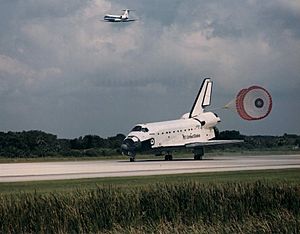STS-71 facts for kids
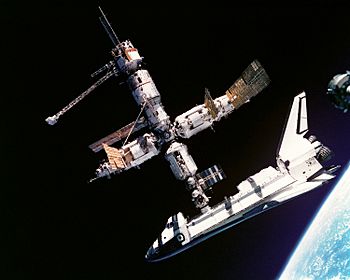
Atlantis docked to Mir, photographed from the departing Soyuz-TM spacecraft Uragan
|
|
| Mission type | Shuttle-Mir |
|---|---|
| Operator | NASA |
| Mission duration | 9 days, 19 hours, 23 minutes, 9 seconds |
| Distance travelled | 6,600,000 kilometres (4,100,000 mi) |
| Orbits completed | 153 |
| Spacecraft properties | |
| Spacecraft | Space Shuttle Atlantis |
| Payload mass | 12,191 kilograms (26,877 lb) |
| Crew | |
| Crew size | 7 up 8 down |
| Members |
|
| Launching |
|
| Landing |
|
| Start of mission | |
| Launch date | 27 June 1995, 19:32:19 UTC |
| Launch site | Kennedy LC-39A |
| End of mission | |
| Landing date | 7 July 1995, 14:55:28 UTC |
| Landing site | Kennedy SLF Runway 15 |
| Orbital parameters | |
| Reference system | Geocentric |
| Regime | Low Earth |
| Perigee | 342 kilometres (213 mi) |
| Apogee | 342 kilometres (213 mi) |
| Inclination | 51.6 degrees |
| Period | 88.9 min |
| Docking with Mir | |
| Docking port | Kristall forward |
| Docking date | 29 June 1995, 13:00:16 UTC |
| Undocking date | 4 July 1995, 11:09:42 UTC |
| Time docked | 4 days, 22 hours, 9 minutes 26 seconds |
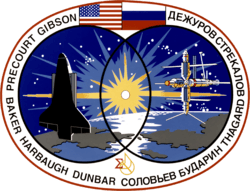 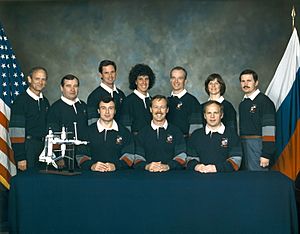 Left to right – Seated: Dezhurov, Gibson, Solovyev; Standing: Thagard, Strekalov, Harbaugh, Baker, Precourt, Dunbar, Budarin |
|
STS-71 was a very important space mission. It was the third mission in the US/Russian Shuttle-Mir Program. It was also the first time a Space Shuttle connected, or docked, with the Russian space station Mir.
The mission began on June 27, 1995. The Space Shuttle Atlantis launched from Launchpad 39A in Florida. Atlantis carried two new Russian cosmonauts, Anatoly Solovyev and Nikolai Budarin, to Mir. It also brought back US astronaut Norman Thagard, who had been living on Mir. Atlantis returned to Earth on July 7, 1995, with a total of eight crew members. This mission was the first of seven times Atlantis would visit Mir.
For five days, Atlantis and Mir were connected. Together, they formed the largest spacecraft ever in orbit at that time! STS-71 was a mission of many firsts. It was the first time a Space Shuttle docked with a space station. It was also the first time a Shuttle crew exchanged members with a station crew. Plus, it was the 100th time the United States launched a crew into space. The mission also carried a special laboratory called Spacelab. It helped resupply Mir with important items. Both the Shuttle and station crews worked together on science experiments. These included studies on life in space and a special amateur radio experiment.
Contents
Meet the STS-71 Space Crew
This mission had a unique crew because some astronauts went up to Mir and others came back to Earth.
| Position | Launching Crew Member | Landing Crew Member |
|---|---|---|
| Commander | Fifth and last spaceflight |
|
| Pilot | Second spaceflight |
|
| Mission Specialist 1 | Third and last spaceflight |
|
| Mission Specialist 2 | Third spaceflight |
|
| Mission Specialist 3 | Fourth spaceflight |
|
| Mission Specialist 4 | EO-19 Fourth spaceflight |
EO-18 Fifth and last spaceflight |
| Mission Specialist 5 | EO-19 First spaceflight |
EO-18 First spaceflight |
| Mission Specialist 6 | None | EO-18 Fifth and last spaceflight |
Key Moments of the Mission
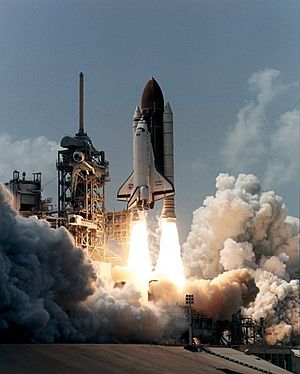
The main goal of STS-71 was to meet and connect with the Russian Space Station Mir. This historic docking happened on June 29. It was the first time in 20 years that a US and Russian (or Soviet) spacecraft docked. Atlantis brought two new cosmonauts, Anatoly Solovyev and Nikolai Budarin, to Mir.
Other important goals included doing joint US-Russian life science experiments. These took place inside the SPACELAB module on Atlantis. The mission also delivered supplies to Mir. Finally, it brought back US astronaut Norman E. Thagard.
The mission also had secondary goals. These included filming with a special IMAX camera. They also did the Shuttle Amateur Radio Experiment-II (SAREX-II).
STS-71 was a mission full of "firsts." It was the 100th time the U.S. launched humans into space from Cape Canaveral. It was the first time a U.S. Space Shuttle docked with a Russian Space Station. It was also the first time a Shuttle crew changed members with a station crew in space. When connected, Atlantis and Mir became the largest spacecraft ever in orbit.
Connecting with Mir: The Docking Process
The journey to Mir began right after launch. Atlantis quickly caught up to the space station. Docking happened at 9 AM EDT on June 29. Atlantis approached Mir from directly below. This method uses natural forces to help slow the Shuttle down. It also means fewer rocket firings are needed.
Commander Gibson manually guided Atlantis for the final part of the docking. He moved the Shuttle to about 10 meters (33 feet) from Mir. Then, he slowly brought it closer. The connection was almost perfect. The docking happened about 400 kilometers (216 nautical miles) above Lake Baikal in Russia.
The Orbiter Docking System (ODS) on Atlantis connected to a similar part on Mir's Kristall module. This system worked perfectly. When connected, Atlantis and Mir weighed about 225 metric tons. That's almost half a million pounds!
After the hatches opened, the STS-71 crew went into Mir. They had a welcoming ceremony. On the same day, the Mir 18 crew officially handed over control of the station to the Mir 19 crew. The two crews then switched spacecraft.
Working Together in Space
For the next five days, the US and Russian crews worked together. They spent about 100 hours on joint operations. They did many biomedical experiments. They also moved equipment and supplies between Atlantis and Mir.
Fifteen different science experiments were done. These used the Spacelab module in Atlantis's cargo bay. The experiments covered many areas, like how the human body works in space. The Mir 18 crew helped as test subjects for these studies. They also did special exercises to get ready for returning to Earth's gravity. They had been in space for over three months.
Many samples were moved from Mir to Atlantis. These included urine, saliva, blood, and air samples. A broken computer from Mir was also transferred. Atlantis also gave Mir over 450 kg (1,000 pounds) of water. It also provided tools for a spacewalk. These tools would help the Mir 19 crew fix a jammed solar array on the Spektr module. Oxygen and nitrogen were also transferred to Mir. This helped increase the air pressure on the station.
Undocking and Return to Earth
Atlantis and Mir undocked on July 4. Before this, the Mir 19 crew temporarily left the station in their Soyuz spacecraft. They wanted to record images of Atlantis and Mir separating. The Soyuz unlatched first. Then, Commander Gibson undocked Atlantis from Mir.
While both spacecraft were undocked, Mir had a computer problem. It started to drift out of position. The Mir 19 crew quickly re-docked to the station. Atlantis watched them. The Mir crew then replaced the computer hardware. This allowed them to get control of the station again.
The returning crew of eight was the largest Shuttle crew ever. To help them get used to gravity again, the Mir 18 crew members (Thagard, Dezhurov, and Strekalov) lay in special seats. These seats were installed in Atlantis before landing.
During the SAREX experiment, the crew talked to several schools. One was Redlands High School in California. Charlie Precourt spoke with students and technicians. He answered questions, including a funny one: "What would happen if you sneezed inside your helmet?" Precourt replied that you would probably "spray your face shield a little bit..." and carry on.



